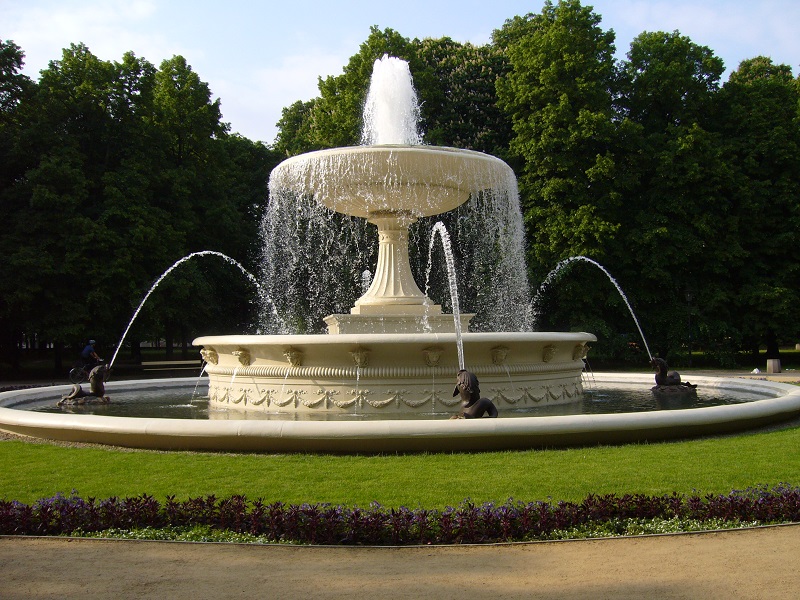Fountain
A fountain is an architectural feature which involves water and is often used as part of landscaping. A fountain can either pour water into a basin to create a ‘waterfall effect’ or spray water into the air to create a ‘jet effect’. Fountains are often used as decorative features in public spaces and gardens.
Drinking fountains are used to provide drinking water public spaces, and special musical fountains combine lights, music and moving water jets for purposes of entertainment. Splash fountains are often used in public spaces and intended for interaction.
The earliest fountains, in Ancient Rome, were functional and used for providing water for drinking and washing. For a water flow to be consistent it required a source (e.g. reservoir or aqueduct) that was higher than the fountain and so was reliant on gravity.
By the end of the 19th century, fountains had been replaced as the main source of drinking water by domestic plumbing and so became primarily decorative. At around this time, gravity was replaced by mechanical pumps which enabled fountains to recycle water and project it into the air. At the start of the 20th century, fountains began to adopt steam pumps and then later on electric pumps to receive water from the source.
Modern fountains rely on a closed recirculating system to recycle water. An electric pump is used to provide the power to push water through the pipes. The pump is typically submerged in the water reservoir and consists of a spinning impellor to draw water in and force it out by centrifugal force. The most appropriate pumping rate will need to be found as the fountain can splash and waste water if it is set too high and will not circulate at all if it is set too low.
Water is delivered to the fountain head and then sprayed into the air through a nozzle or left to flow outside the fountain. In both cases the water will fall back onto the fountain and drain back into the reservoir. Larger fountains will often be fitted with multiple nozzles and pumps.
A filter known as a media filter, is used to remove particles from the water as it is circulated. It is fitted with its own pump and plumbing to take water from the pool to the filter and back to the pool. The water can be cleaned using treatments such as chlorination or anti-algal methods.
A ‘plant room’ is provided to store the pumps, filter, electrical switch box and plumbing controls, and this must be well-constructed so as not to leak and create a hazard. Fountains can often use low-voltage lighting, often submerged in the water, which minimises hazards.
Water in a fountain is gradually lost due to evaporation so it must be topped up at certain times, and allowances made to be able to cope with overflow after heavy rain.
Some notable fountains include:
- King Fahd’s Fountain, Jeddah, Saudi Arabia: Jets water 260 m into the air making it the world’s highest continually-running fountain.
- Jet d’Eau fountain, Geneva, Switzerland: First modern high-shooting fountain, completed in 1951.
- Bellagio Hotel & Casino musical fountain, Las Vegas: Famous choreographed fountain with pivoting nozzles which vary the water patterns.
- Buckingham Fountain, Chicago: One of the world’s largest fountains, it is designed in a Rococo wedding cake-style.
- Trevi fountain, Rome, Italy: Large Baroque fountain completed in 1762.
[edit] Related articles on Designing Buildings
Featured articles and news
Infrastructure that connect the physical and digital domains.
Harnessing robotics and AI in challenging environments
The key to nuclear decommissioning and fusion engineering.
BSRIA announces Lisa Ashworth as new CEO
Tasked with furthering BSRIA’s impressive growth ambitions.
Public buildings get half a million energy efficiency boost
£557 million to switch to cleaner heating and save on energy.
CIOB launches pre-election manifesto
Outlining potential future policies for the next government.
Grenfell Tower Inquiry announcement
Phase 2 hearings come to a close and the final report due in September.
Progress from Parts L, F and O: A whitepaper, one year on.
A replicated study to understand the opinion of practitioners.
ECA announces new president 2024
Electrical engineer and business leader Stuart Smith.
A distinct type of countryside that should be celebrated.
Should Part O be extended to existing buildings?
EAC brands heatwave adaptation a missed opportunity.
Definition of Statutory in workplace and facilities management
Established by IWFM, BESA, CIBSE and BSRIA.
Tackling the transition from traditional heating systems
59% lack the necessary information and confidence to switch.
The general election and the construction industry
As PM, Rishi Sunak announces July 4 date for an election.
Eco apprenticeships continue help grow green workforce
A year after being recognised at the King's coronation.
Permitted development rights for agricultural buildings
The changes coming into effect as of May 21, 2024.






















